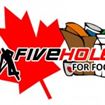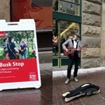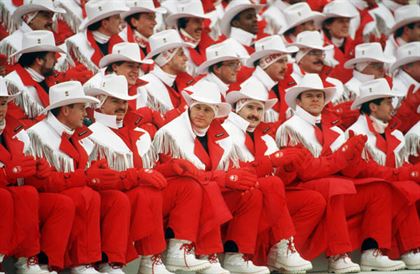 Canada’s 1998 Calgary Olympians (Retrieved from Collections and Archives Canada)
Canada’s 1998 Calgary Olympians (Retrieved from Collections and Archives Canada)
Looming large in media coverage and daily conversation is the potential for a 2026 Olympic bid by the City of Calgary. Neighbours, friends, and co-workers fall on opposite sides of the debate and argue fiercely about the pros and cons of such a bid. Those who vie for the Olympic Games to make their return to Calgary often cite the success of the 1988 Games. The first Olympic Games to be held over a two-week period, Calgary beat out cities in Italy and Sweden for the right to host. Calgary had bid previously, losing to Innsbruck, Austria in 1964 and Grenoble, France in 1968.
In May of 1980, Calgary was awarded an NHL franchise. The Atlanta Flames moved north to become our beloved Calgary Flames and the Saddledome was built to house the team. The dome featured prominently in the 1988 Olympic bid. Calgary, then a city of 600,000, was still relatively unknown on the international stage. According to CBC, when the games were awarded to Calgary, American journalists began to call the Tourist and Convention Association to ask if there were any hotels in Calgary. There are also reports of the mayor of Cagliari, a city in Italy, receiving congratulatory telegrams!
Calgary’s bid was hotly contested. Italy waged an aggressive campaign, citing Canada’s boycott of the 1980 Olympics in Moscow as a major reason why the games should not be awarded to Calgary. When the city’s name was announced, CBC was on hand to capture the excitement. Original CBC radio recordings exist of Frank King, largely seen as the driving force behind the ’88 Olympic Bid, expressing his absolute joy at the news. He is heard saying: “Calgary will become more of an international city than ever before. It’s the kind of city that is very dynamic but is not well-known around the world. I think the people of the world should look forward to coming to Calgary. You’ll find it exciting. […] We will put on the best Olympic games that have ever been held.”
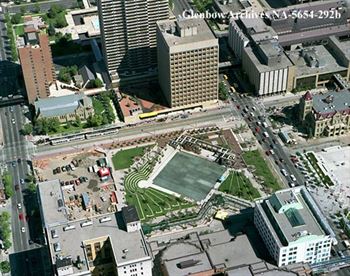 Aerial View of Olympic Plaza, June 1988 (Retrieved from the Glenbow Museum)
Aerial View of Olympic Plaza, June 1988 (Retrieved from the Glenbow Museum)
The Winter Olympics weren’t known as a revenue generator in the way that the Summer Olympics were. The Calgary committee convinced the IOC that they could make the Winter Olympics profitable and promote a lasting legacy of winter sporting excellence. The timeline of the Games was stretched out to encompass an additional weekend and record sponsorship and television revenue was generated. The Games cost more than any other had before it, but the venues were designed for lasting use and public benefit. Calgary’s Olympic infrastructure still stands – the Saddledome, Canada Olympic Park, and the Olympic Oval to name a few. More than 22,000 Calgarians vied for just over 9,000 volunteer roles.
Canada failed to win a gold medal, but the ’88 Olympics gave us a lot to remember! Eddie the Eagle, recently the subject of a Hollywood film, famously competed in ski jumping, and the Jamaican bobsled team, also the subject of a popular movie, saw their Olympic debut here in Calgary.
The 1988 Olympic Games left a lasting legacy on Calgary’s downtown. Olympic Plaza was constructed at 228 8 Ave SE as the site for medal ceremonies. It now serves as a beautiful park and gathering space, houses the Famous Five statue, boasts a stage and seating area, and is the city’s only refrigerated outdoor ice surface for public skating in the winter. Stampede Caravan breakfasts are served in the Plaza every July, and the stage provides Stampede entertainment.
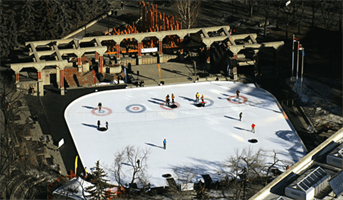 Present Day Olympic Plaza (Retrieved from Medicine Hat News)
Present Day Olympic Plaza (Retrieved from Medicine Hat News)
Olympic Plaza is lined with 35,046 bricks purchased by Calgarians for $20. These bricks had the names of their donor etched into them and immortalized the purchaser in the Plaza. Looking for a specific brick purchased by a friend or family member used to be next to impossible. Locations of specific bricks were detailed in a 556-page book, listed in reference to a particular “key brick” corresponding to a winter sport. This meant that a specific brick might be simply identified as being near a particular sport – highly inconvenient! Local Ron McMahon donated his time to the creation of an app called the Olympic Plaza Brick Finder that will guide you through GPS to any brick of your choice. It took him four years. Not all heroes wear capes!
Whether you agree with the feasibility of a 2026 bid or not, there is no denying the impact the ’88 Games had on the city of Calgary. It brought people together in the spirit of volunteerism (even decades later as demonstrated by Ron McMahon), provided international recognition for the city, proved that the Winter Olympics were just as exciting as the Summer Games, and left a lasting legacy downtown!
Related Posts
| Tweet |
|

